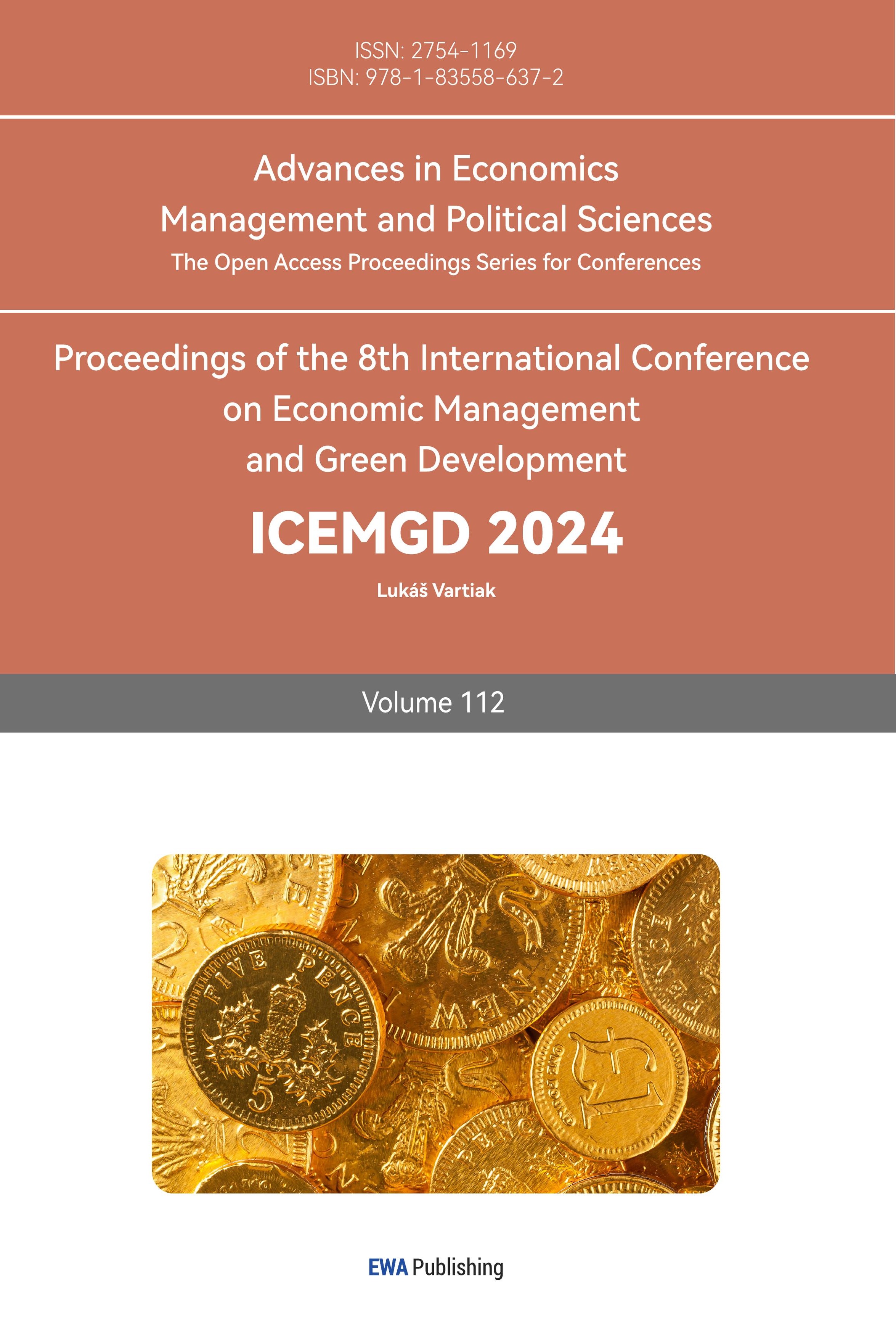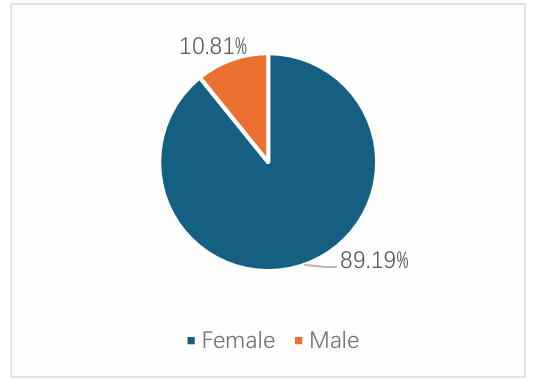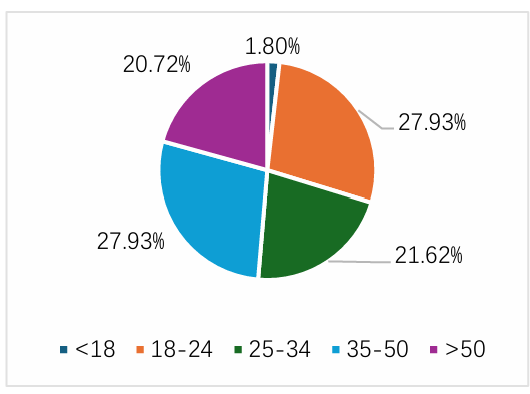1.Introduction
In today's society, social media has a growing influence on people's daily lives. Many individuals have developed a habit of shopping by using social media platforms.
To begin with, women are gradually playing an increasingly important role in society, often possessing multiple identities, including daughters, mothers, and wives. In daily consumption, people will also purchase different types of goods due to their different identities. Female consumers also occupy a place on social networks, and the frequency of online shopping is much higher than that of men. More and more products are being recommended and live streamed on social platforms, and the model is changing. Especially in the beauty industry, many bloggers, to some extent, sell beauty products. What platforms do famous beauty bloggers rely on, and the current situation of using social platforms for beauty products.
In recent years, there has been an increasing amount of research on the consumption structure and marketing strategies of social network platforms. Yan proposed that most female consumers care more about appearance, summarizing several marketing strategies such as establishing a good reputation, pricing products reasonably, strengthening website interface design, adopting various promotional methods, and enhancing shopping satisfaction [1]. Xiao proposed that female consumers pay attention to cost performance, scrutinize product specifications very strictly, and tend to engage in emotional consumption more often. Online shopping platforms should pay more attention to personalized customization, offline experiences and sales channel diversification [2]. Chen et al. took female consumers in Dongguan as an example and presented four empirical hypotheses. The quality of online word-of-mouth, the characteristics of the communication platform, the credibility of word-of-mouth reviewers, and the perceived value of consumers have a positive and significant impact on consumers' purchase decisions [3]. Li pointed out that high prices can be set for new products and personalized products with the help of the price psychological criteria of female consumers' unique sensitivity and comparison psychology [4]. Shan and Yu conducted a survey and research on female consumption behavior in the context of network broadcast, and found that women have herd consumption behavior and weak awareness of rights protection, which leads to the advocation that women need to establish a correct concept of consumption [5]. Han found that opinion leaders and word-of-mouth communication have become the main factors affecting consumption, interactive communication in shopping communities enhances user stickiness [6]. Liu pointed out that women's online consumption is prone to addiction, for the reason that the consumption process of online shopping is very simple, which greatly saves labor costs and time costs [7]. Lu pointed out that the network broadcast industry shows a "live +" ecological trend, combined with major industries to build a diversified live broadcast ecosystem, which changes of consumption behavior from timeliness to delay has become another feature of network live broadcast consumption [8]. He pointed out that the brand special live broadcast is to promote the rural consumer groups to intuitively understand the brand characteristics [9]. Liu and Zou pointed out that the essence of live agricultural products economy is mainly manifested as the user's attention economy, body sense economy, and relationship economy [10]. Zhou proposed that female consumption shows the characteristics of equal emphasis on quality and practicality, paying more attention to individuation and differentiation, and more inclined to online consumption channels [11]. Li proposed that modern people are actively using social networking services as a means of information exploration in order to purchase necessary items [12].
Therefore, the analysis of marketing of beauty products in this paper can not only provide reference for beauty companies to understand consumer behavior in practice and adopt better marketing strategies, but also further enrich the research on social platforms in a theoretical sense and provide an important supplement for the research on online consumption structure and marketing of beauty products. This study mainly focuses on the impact of social media on women's consumption behavior in the beauty products.
2.Method
This paper adopts the method of questionnaire survey. A total of 15 questions were designed, including consumers' age range, geographical region, urban development, frequency of using social media, social media platforms most frequently used, attention to online advertising and live broadcasting of beauty products, consumption preferences, and influences by different marketing methods and content.
3.Results
3.1.Basic Information
This survey was conducted through online channels, resulting in 111 responses related to beauty product consumption patterns. The primary respondents were females, constituting 90% of the total participants (figure 1).
Regarding age distribution, individuals aged 18-24 and 35-50 each accounted for 27.93% of respondents, while those aged 25-34 represented 21.62%. Participants over 50 years old comprised 20.72%. While those under 18 being the smallest group, only accounted for 1.8% (figure 2). The survey primarily targeted economically independent adult women capable of making their own purchasing decisions.
|
Figure 1: Gender distribution |
Figure 2: Age distribution |
Geographically, respondents from first-tier cities such as Beijing, Shanghai, Guangzhou, and Shenzhen constituted a significant portion at 45.05%. Those from non-first-tier provincial capital cities accounted for 27.93%, followed by other urban areas at15 .32%. Rural participants made up only1 .8%, while an additional 9 .09% were located overseas in regions including Britain, Canada, Malaysia, and Singapore (figure 3).
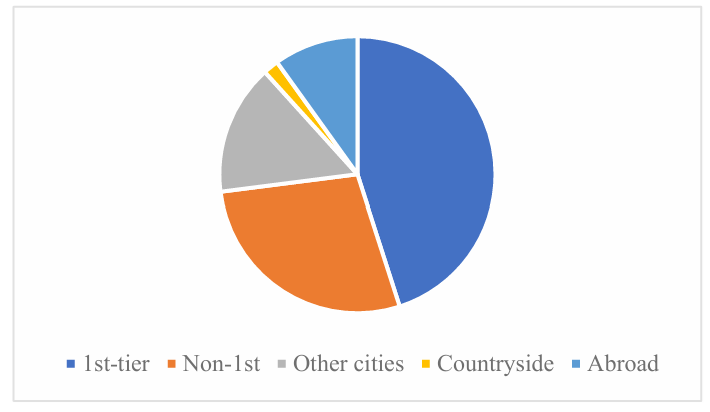
Figure 3: Districts
3.2.Frequency analysis of social platform use
In terms of how much time are spending on social media platforms: 35 .14% of the participants reported they spend one to three hours on social medias. 31 .53% of the participants spent over three hours. 23 .42% of the participants spent 30 minutes to 1 hour. Only 9 .91 % of the participants spent less than 30 minutes per day on social medias (figure 4).

Figure 4: Time distribution
3.3.Preference analysis of online shopping
The most frequently used social media platforms among participants included WeChat, Taobao, JD.com (these two are E-commerce platform), RED (which is similar to Pinterest), Chinese TikTok, Weibo, bilibili (which is similar to YouTube), and international platforms like Instagram, YouTube, and Facebook which are not directly accessible within mainland China. Additionally, Baidu (which is similar to Google), Chinese Quora, these knowledge-sharing applications were utilized by 2 .7% of the participants (figure 5).
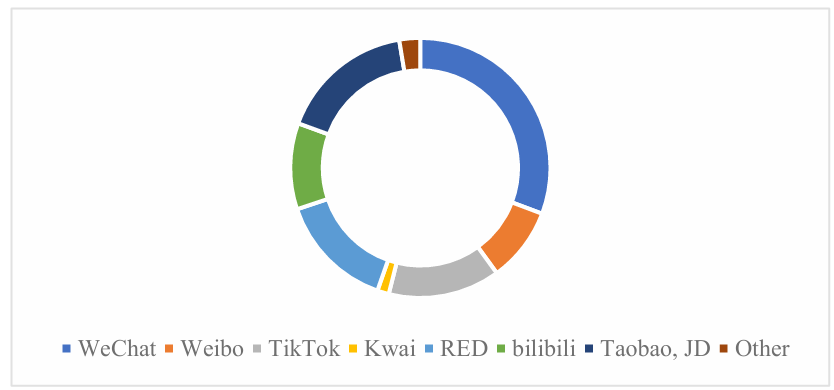
Figure 5: Social platform
Approximately half of respondents indicated that they watch advertisements or live streams featuring beauty products on social media. However, the remaining 49.55 % expressed no interest in doing so.
The majority (58.56%) preferred promotional videos or live broadcasts showcasing products tailored to their specific needs. Furthermore, a substantial proportion valued practical product functionality (20.72%), while 11.71% emphasized engaging advertising narratives and plots. Only 9.01% of the participants thought that whether the appearance of the products is pretty or not is most important when making shopping decisions (figure 6).
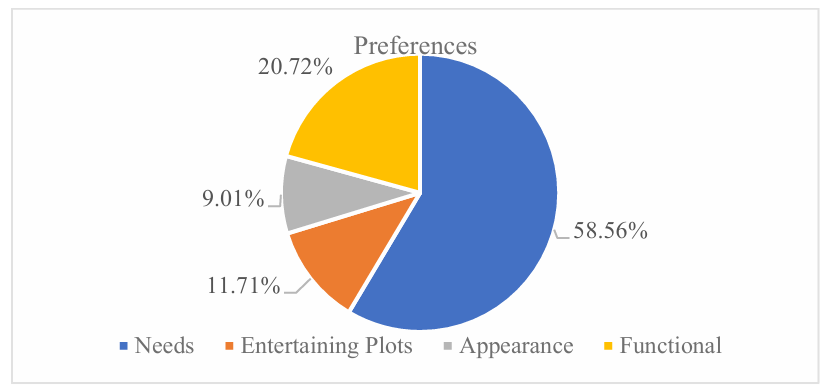
Figure 6: Preferences
When considering celebrity endorsements' impact: Merely 35.14% of the participants stated that they would be more likely to purchase a beauty product if endorsed by influencers or celebrities that they like. In the contrary, a significant 64.86% of the participants indicated that this factor did not affect their purchasing decision-making process. Nevertheless, when the products are endorsed by the influencers or celebrities that participants dislike, most people(exactly 59.46%)will reduce the probability of buying the specific beauty products. This suggests that aversion towards certain public figures has a more pronounced effect on consumer behavior compared to positive associations with celebrities or influencers.
Concerning peer influence: A striking 79.28% expressed reliance upon browsing through customer reviews before making cosmetic purchases via comments sections or similar buyer feedback forums. Conversely, the remaining 20.72% were unaffected by such input.
It can be seen that the Internet platform has many advantages. As an essential part of daily life for modern people, it connects consumers from all over the world. Therefore, beauty products should make good use of the network platform to attract consumers.
3.4.Category analysis of online shopping
As shown in figure 7, beyond beauty products: The majority (73.87%) also expressed interest in clothing advertisements or live streams, followed by 55.86% of the participants have interests in daily necessities and 35.14% of the participants have interests in accessories such as earrings and necklaces. Other categories including electronics (24.32%), decorative items/ toys (19.82%), maternal and infant products (7.21%), as well as health-related items/ investments/ food/ beverages (4.5%).
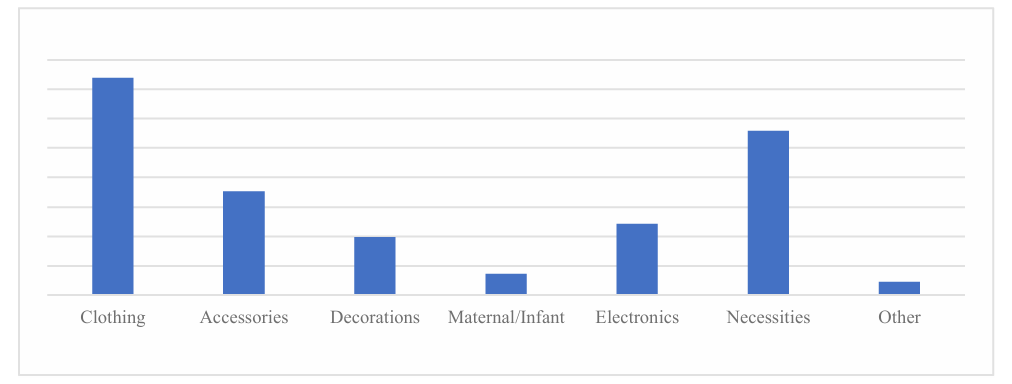
Figure 7: Categories
Additionally, 52.25% of the participants claimed that they have purchased recommended beauty products featured in content delivered via personalized recommendations across various social media channels. However, the remaining 47.75% did not engage in such practices extensively.
In terms of feedback sharing, only 25.23% of the participants have shared their experiences or evaluations regarding beauty products across social media platforms with the vast majority 74.77% opting not to do so. Finally, in terms of planned purchases, during online promotional events (such as Double 11 Shopping Festival and 618 Mid-Year Shopping Festival) 65.77% intended to purchase beauty products on impulse without prior intentions. Those who did not engage in such behavior accounted for 34.23% of participants.
4.Conclusion
Female consumers in all regions watch live broadcasts and advertisements of beauty products on social platforms and make selection and consumption decisions. The effect of live advertising is wide, covering various types of products. Online shopping is most concentrated among young people. They use social platforms frequently in their daily lives and tend to communicate and obtain information with their peers on the Internet. These consumers will make purchases according to their own needs, and most people will not make impulse purchases because of appearance. The more practical the product, the more popular it is. In addition, online shoppers are greatly affected by public opinion and others' evaluations, and are very concerned about Internet celebrities and promotional activities. The supply and demand of product evaluation are not coordinated.
The trend of “She-economy” has led female consumers to become more self-conscious. This also explains why clothing and accessories account for a large proportion of women's consumption structure.
The high frequency use of the Internet has caused modern people to gradually develop a tendency of social fear. Most consumers say that when shopping offline in shopping malls, they are more resistant to accepting shopping guide services. However, in online shopping, non-face-to-face communication makes the communication between consumers and merchants smoother and effective.
Most of the female online shoppers are 9-to-5 office workers or college students, with relatively high education level, busy daily affairs and work, and a faster pace of life. In this context, live broadcasting and online advertising should be more concise, convey the most useful information in the shortest time, and help consumers make consumption decisions the fastest. At the same time, most consumers watch live broadcasts and advertisements in public places such as offices or classrooms, which need to maintain a certain degree of quiet, so live broadcasts and advertisements can add voice recognition subtitles or display important information on the screen. In this way, watchers do not have to turn on the speaker or wear headphones to get effective information.
According to the research of this paper, the following suggestions are put forward for product marketing. In network marketing, it is necessary to strengthen the pertinency of specific groups, use information statistics and big data technology, combined with the search and record function of social platforms, and accurately evaluate the social positioning of the products sold to the crowd and each consumer. The biggest help of social platforms for product sales is to enhance brand awareness, so brands need to summarize their main advantages, match with consumer needs, and meet personalized needs. Practicality is the main concern of online shopping consumers, so social platform merchants should not spend too many resources on product packaging. Good appearance may attract consumers to watch advertisements, but what really makes consumers make a purchase decision is the practical value of the goods placed on the Internet.
Not all products are suitable for online shopping, product types with high quality requirements should choose other sales channels. Such as maternal and infant products and health care products. Trinkets, for example, which are widely available at low prices and are easily affected by the mood of consumers, are also not suitable for online sales.
References
[1]. H. Yan (2022). Analysis of marketing strategies based on consumer psychology of female online shopping groups. Northern Economy and Trade (01),72-74.
[2]. P. Xiao (2021). Discussion on female consumption behavior and network marketing Strategy in e-commerce. China Collective Economy (18),55-56.
[3]. X.F. Chen, M.J. Zhou, X.Y. Yin (2019). The influence of online word-of-mouth on skin care consumption decision: A case study of female consumers in Dongguan. Modern trade industry (27), 64-65. The doi: 10.19311 / j.carol carroll nki. 1672-3198.2019.27.030.Li Dan (2019). Research on network marketing strategy based on female consumption characteristics.
[4]. D. Li (2019). Research on network marketing strategies based on female consumption characteristics. Research productivity (07) 93-97. The doi: 10.19374 / j.carol carroll nki. 14-1145 / f 2019.07.015.
[5]. S.Y. Shan, H.L. Yu (2021). Investigation and Research on Female Consumption Behavior in the context of network broadcast. Shanghai Commerce (09),22-23.
[6]. L.J. Han (2018). Analysis on the impact of new media social marketing on women's fashion consumption. News Research Guide (06),89.
[7]. X.J. Liu (2017). Analysis of current situation and new characteristics of female consumption based on new media communication. News Communication (01),29-30.
[8]. Y.J. Lu (2022). The impact of network broadcast on female entrepreneurship and consumption patterns. Journal of Hebei university of open (5), 76-79. The doi: 10.13559 / j.carol carroll nki HBGD. 2022.05.017.
[9]. T.W. He (2023). The impact of brand special live broadcast on the upgrading of rural consumption structure from the perspective of rural revitalization. Research in Business Economics (23),112-115.
[10]. X.N. Liu, Z.L. Zou (2023). Perspective on the economy of agricultural products livestreaming industry and Mass consumer psychology under Network new media. China (30), 183-186. The doi: 10.13939 / j.carol carroll nki ZGSC. 2023.30.183.
[11]. C.M. Zhou (2024). The distribution of listed companies with fast growth and great potential of "She economy" accelerated. The securities times, how A02. Doi: 10.38329 / n.c. Nki NZJSB. 2024.001534.
[12]. Y.Z. Li (2022). The Influence of the characteristics of beauty Internet celebrities on information Reception and Purchase Intention Master's Degree (Dissertation, Shanghai University of Finance and Economics). Master of https://link.cnki.net/doi/10.27296/d.cnki.gshcu.2022.000748doi:10.27296/d.cnki.gshcu.2022.000748.
Cite this article
Yang,H. (2024). Research on the Social Media Marketing on Beauty Product: Based on Questionnaire Method. Advances in Economics, Management and Political Sciences,112,169-175.
Data availability
The datasets used and/or analyzed during the current study will be available from the authors upon reasonable request.
Disclaimer/Publisher's Note
The statements, opinions and data contained in all publications are solely those of the individual author(s) and contributor(s) and not of EWA Publishing and/or the editor(s). EWA Publishing and/or the editor(s) disclaim responsibility for any injury to people or property resulting from any ideas, methods, instructions or products referred to in the content.
About volume
Volume title: Proceedings of the 8th International Conference on Economic Management and Green Development
© 2024 by the author(s). Licensee EWA Publishing, Oxford, UK. This article is an open access article distributed under the terms and
conditions of the Creative Commons Attribution (CC BY) license. Authors who
publish this series agree to the following terms:
1. Authors retain copyright and grant the series right of first publication with the work simultaneously licensed under a Creative Commons
Attribution License that allows others to share the work with an acknowledgment of the work's authorship and initial publication in this
series.
2. Authors are able to enter into separate, additional contractual arrangements for the non-exclusive distribution of the series's published
version of the work (e.g., post it to an institutional repository or publish it in a book), with an acknowledgment of its initial
publication in this series.
3. Authors are permitted and encouraged to post their work online (e.g., in institutional repositories or on their website) prior to and
during the submission process, as it can lead to productive exchanges, as well as earlier and greater citation of published work (See
Open access policy for details).
References
[1]. H. Yan (2022). Analysis of marketing strategies based on consumer psychology of female online shopping groups. Northern Economy and Trade (01),72-74.
[2]. P. Xiao (2021). Discussion on female consumption behavior and network marketing Strategy in e-commerce. China Collective Economy (18),55-56.
[3]. X.F. Chen, M.J. Zhou, X.Y. Yin (2019). The influence of online word-of-mouth on skin care consumption decision: A case study of female consumers in Dongguan. Modern trade industry (27), 64-65. The doi: 10.19311 / j.carol carroll nki. 1672-3198.2019.27.030.Li Dan (2019). Research on network marketing strategy based on female consumption characteristics.
[4]. D. Li (2019). Research on network marketing strategies based on female consumption characteristics. Research productivity (07) 93-97. The doi: 10.19374 / j.carol carroll nki. 14-1145 / f 2019.07.015.
[5]. S.Y. Shan, H.L. Yu (2021). Investigation and Research on Female Consumption Behavior in the context of network broadcast. Shanghai Commerce (09),22-23.
[6]. L.J. Han (2018). Analysis on the impact of new media social marketing on women's fashion consumption. News Research Guide (06),89.
[7]. X.J. Liu (2017). Analysis of current situation and new characteristics of female consumption based on new media communication. News Communication (01),29-30.
[8]. Y.J. Lu (2022). The impact of network broadcast on female entrepreneurship and consumption patterns. Journal of Hebei university of open (5), 76-79. The doi: 10.13559 / j.carol carroll nki HBGD. 2022.05.017.
[9]. T.W. He (2023). The impact of brand special live broadcast on the upgrading of rural consumption structure from the perspective of rural revitalization. Research in Business Economics (23),112-115.
[10]. X.N. Liu, Z.L. Zou (2023). Perspective on the economy of agricultural products livestreaming industry and Mass consumer psychology under Network new media. China (30), 183-186. The doi: 10.13939 / j.carol carroll nki ZGSC. 2023.30.183.
[11]. C.M. Zhou (2024). The distribution of listed companies with fast growth and great potential of "She economy" accelerated. The securities times, how A02. Doi: 10.38329 / n.c. Nki NZJSB. 2024.001534.
[12]. Y.Z. Li (2022). The Influence of the characteristics of beauty Internet celebrities on information Reception and Purchase Intention Master's Degree (Dissertation, Shanghai University of Finance and Economics). Master of https://link.cnki.net/doi/10.27296/d.cnki.gshcu.2022.000748doi:10.27296/d.cnki.gshcu.2022.000748.





